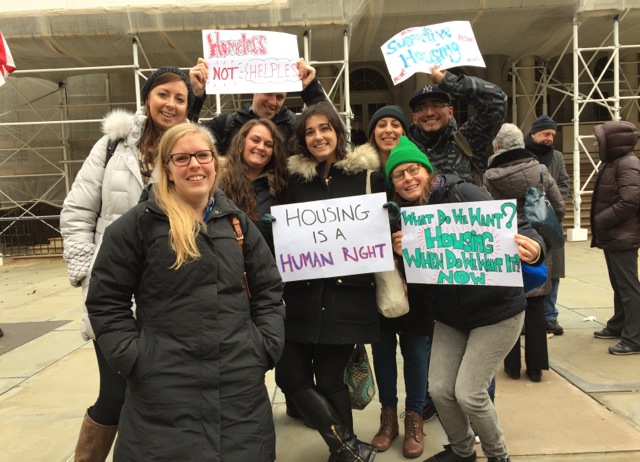In Support of Council Efforts to Diversify City Schools
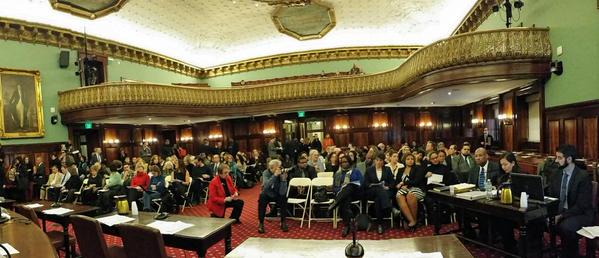
Council Chambers during Thursday's packed hearing (photo: @MarkLevineNYC)
There is no more important factor than classroom diversity to assure quality education and a just society for our children. I commend the New York City Council for its courage in addressing this issue since we know that actions to correct segregation are almost as painful and politically dangerous as a failure to act.
Recently, I have discussed the need to adjust the Department of Education's policies around the placement of so-called "over-the-counter" students; single-test admissions to the city's elite high schools; and the school choice system.
On Thursday, I testified at the City Council, expressing wholehearted support for legislation to require the DOE report each year on diversity in the city's schools (Int. 511) and calling on the DOE to officially establish diversity as a priority in admissions policies and practices (Res. 453). These are necessary steps to focus the Department of Education's attention on schools and school processes that limit diversity. Every time a selection procedure fails to provide for diversity of academic, economic, geographic, racial, linguistic, gender, and ethnic populations, the DOE should have to justify not just the reasons for disproportionate inclusion of certain groups but why others are excluded.
We know from studies of student progress that all gain from exposure to difference. Even if, in a given school, test scores go up or down, individual student scores do not decline and the humans behind those scores infinitely profit from diversity's cognitive, affective, and social benefits. If the administration is serious about reducing pressure on test scores, that will have the beneficial effect of reducing pressure on principals to pre-select high scoring students.
When we ignore the importance of diversity in the name of privilege or identity, we take a step backward in fulfilling the American promise. Current crises of racial polarization, income inequality, and sexual predation are tied to the limited opportunities and demographic isolation inherent in segregated school settings. Int. 511 and Res. 453 put the Council squarely on record promoting those goals.
In qualifying my support for the third piece of legislation at hand on Thursday (Res. 442), I note my long and vigorous involvement in the federal complaint against the current Specialized High School exam which has a clear, shameful discriminatory impact against Black and Latino students.
The test also fails to meet modern standards of merit-based admission practiced by other selective high schools and colleges nationally. The exam's single great appeal is that it sorts quickly and numerically, inducing a test centered culture mired in racial bigotry. But to my mind the answer is not to amend New York State Education Law 2590-h(1)(b), which requires the test admissions practice, but to repeal it.
Why should the State Legislature be dictating selection procedures at all, setting in stone criteria which will always be, at best, imperfect? I prefer to devolve selection procedures to the city, without this strange legislative strangle-hold established by Calandra-Hecht in 1971.
***
David C. Bloomfield is Professor of Educational Leadership at Brooklyn College and the CUNY Graduate Center.
***
Have an op-ed idea or submission for Gotham Gazette? Email editor Ben Max: This email address is being protected from spambots. You need JavaScript enabled to view it.
Renewed Supportive Housing Legislation is a Must
Staff from Goddard's Manhattan Outreach Consortium at the NY/NY Press Conference
On December 8, a press conference was held on the steps of City Hall on behalf of the Campaign 4 NY/NY Housing. Undeterred by the cold, housing advocates, politicians, and formerly homeless individuals gathered to make their voices heard and to show support while City Council Member Steve Levin introduced a resolution to urge the Mayor and Governor to sign a new NY/NY agreement that would create additional units of supportive housing over the next ten years. To date, both Mayor Bill de Blasio and Governor Andrew Cuomo have stated that they would support a NY/NY IV, but neither has taken the next step to sign an agreement.
Why do we need additional units of supportive housing?
NYC homelessness is at a record high and Goddard Riverside Community Center believes that housing is a human right. It is something that each New Yorker deserves and we must ensure access.
The number one cause of homelessness is not unemployment, it is not issues related to substance abuse, nor is it ramifications of mental health problems. The number one cause of homelessness in our city, and indeed our nation, is a lack of affordable housing.
NY/NY III, the 2005 City-State agreement that provided 9,000 units of supportive housing over ten years, expires next year. A new initiative, NY/NY IV, is necessary to ensure that the creation of supportive housing does not stop. Demand has certainly not stopped. According to the Campaign 4 NY/NY Housing, for every six New Yorkers hoping (and eligible) to get a home where he or she can have a stable place to rest, to shower, to prepare a meal for his family, only one will be granted access to that home. While this number is shamefully high, it will only continue to rise if a new agreement to build additional units of supportive housing is not signed soon.
For those more swayed by economic rather than social costs, supportive housing has been proven to be a cost saving measure at a time when city and state budgets are already tight. Homeless individuals utilize emergency services, hospitals, and the criminal justice system at higher rates than those who are not homeless. When the cost of using the shelter system is also factored in, the Campaign 4 NY/NY cites that placing an individual in supportive housing saves over $10,000 per year. By this logic, place ten people in supportive housing and save over $100,000. This model has also proven to be a sustainable one that will continue to save the city and state money as people remain housed. Of all of the clients placed into permanent housing through Goddard Riverside and the Manhattan Outreach Consortium in 2013, a remarkable 92% remain housed after one year.
As the adage goes, the measure of a society is how it treats its most vulnerable members. We've got some work to do.
***
Allison McCullough is a Program Director with Goddard Riverside Community Center's Manhattan Outreach Consortium. On Twitter: @goddardriv
***
Have an op-ed idea or submission for Gotham Gazette? Email editor Ben Max: This email address is being protected from spambots. You need JavaScript enabled to view it.
More Justice, Less Politics - In Every Borough

Mayor de Blasio, left, and Brooklyn DA Ken Thompson (photo: @BilldeBlasio)
Amidst calls for special prosecutors, public hearings, and the attorney general to take over, Brooklyn District Attorney Ken Thompson has stridently defended the prerogative of his office to call a grand jury in the police killing of Akai Gurley.
It's his "duty" as Brooklyn's "duly elected district attorney" to pursue cases of police brutality, Thompson says. And citing the Ferguson and Staten Island decisions, Congressman Hakeem Jeffries, a key Thompson ally, notes that when it comes to grand juries, "prosecutors often get their wish."
Both figures may be well-intentioned proponents of police accountability, but their statements nonetheless illustrate the core problem with the grand jury process in such cases. The outcomes often boil down to politics, not law.
A closer look at the potential jury pools in Staten Island and Brooklyn illustrates the point.
Though it's becoming more diverse, Staten Island's population remains largely white, with blacks numbering about 12%. Nearly 30% of the borough's 265,000 registered voters are Republicans. About 45% of the island's potential voters are registered Democrats, but those ranks are not dominated by progressives.
The last Democrat to carry Staten Island in the mayor's race was Ed Koch (in 1985), a conservative on law-and-order issues. And while Joe Lhota lost by a landslide in the mayor's race last fall, he did carry the island, beating de Blasio 53-44%.
Staten Island, of course, is also home to many current and retired NYPD officers. There are 3,000 active duty cops living there, and together with retirees and jury-eligible family members, they constitute a vocal bloc.
As a result, "it would be difficult to empanel a grand jury in Staten Island that is not sympathetic to cops," observes veteran city reporter Wayne Barrett. "But it certainly doesn't seem like the D.A. wanted to go to trial."
In addition, D.A. Dan Donovan called a special grand jury, which makes more demands on jurors' time. Not many working people can commit to a schedule requiring a few daytime visits per week over the course of several months.
In general, this increases the likelihood that housewives and retirees are over-represented on the final panel. We don't know the occupational status of Garner jurors, but 15 of the 23 jurors were white—and based on the composite sketch above, they were likely to be sympathetic to the police.
Donovan, a Republican, is up for reelection in 2015, and he's also been mentioned as a possible contender for Michael Grimm's congressional seat, should the latter be forced to resign due to his legal troubles. In terms of his own career, Donovan had more to lose than gain by pursuing an indictment in the Garner case.
Demographically and otherwise, there's very little similarity between New York City's smallest borough and its most populous. For starters, Brooklyn is more diverse, checking in at 36% white, 32% black, 20% Latino and 10% Asian.
There are also nearly 930,000 registered Democrats in Brooklyn, as opposed to only 115,000 Republicans. While Bill Thompson (no relation to DA Ken) carried Brooklyn in the 2009 mayoral campaign (52-45%), last year de Blasio, running as a progressive with a police reform agenda, easily beat Thompson in the primary (46-27%) before crushing Lhota, the 'get tough' law and order candidate, in the general election (78-20%).
After successfully toppling long-time incumbent Joe Hynes last year, Ken Thompson, unlike Donovan, is not facing reelection, nor is he yet a potential candidate for another office. Meanwhile, it's more likely that amidst the outrage over the Garner decision, an indictment (and possibly a conviction) in the Gurley case will help more than hurt him politically.
Such glaring differences between two neighboring jurisdictions create different scales of justice. While Thompson may be able to show that the grand jury process "works" in Brooklyn, it's just as likely to remain biased in favor of police in Staten Island.
In the name of equality under the law, and in the same city, the fairest solution is thus to implement one identical process in all major cases involving police misconduct.
***
Theodore Hamm (@HammerDaily) is chair of journalism and new media studies at St. Joseph's College in Clinton Hill, Brooklyn.
***
Have an op-ed idea or submission for Gotham Gazette? Email editor Ben Max: This email address is being protected from spambots. You need JavaScript enabled to view it.
New York's Signature College Aid Program Turns 40, But Falls Short of Meeting Needs
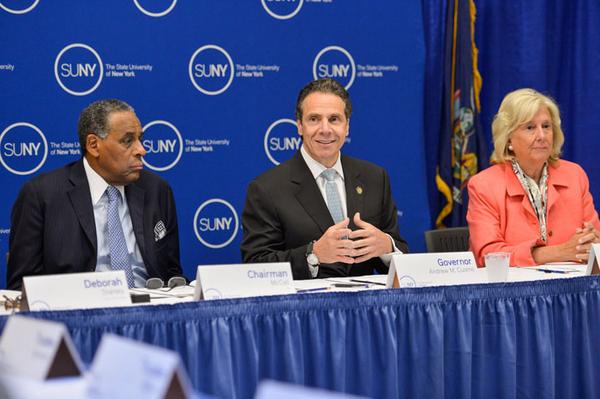
Gov. Cuomo making a SUNY-related announcement (photo: @NYGovCuomo)
The Tuition Assistance Program can't keep up with soaring tuition costs without comprehensive reform.
Total student loan debt in the U.S. is currently more than $1 trillion, surpassing credit card and auto-loan debt. This debt is not only threatening young graduates' ability to fully participate in the economy, but also suffocating too many families and middle-aged adults. According to the New York Federal Reserve, 30-year-old student debt holders are less likely to own a home and more likely to delay their own retirement.
Sixty percent of New York college graduates – nearly 3 million residents – incur debt, with a total of $73 million and an average amount of more than $25,000. To make matters worse, median wages for people between the ages of 25 and 34 have fallen in every major industry except healthcare.
Unfortunately, New York State has responded by cutting funding and increasing tuition. In fact, over the last two decades, average tuition and fees at public four-year colleges in New York have risen 127 percent while students continue to foot the bill. Since 2008, New York State cut nearly $2 billion to higher education. Tuition at the State University of New York (SUNY) has increased by $1,550 and at the City University of New York (CUNY) by $1,700. Those costs will continue to grow as a result of the NY SUNY 2020 "Rational Tuition Bill," which is scheduled to raise tuition at public colleges by $300 annually for five consecutive years.
Meanwhile, New York State's signature college aid program – the Tuition Assistance Program (TAP), which turned 40 this year – has remained grossly inadequate, leaving too many New Yorkers behind.
After years of cuts to this $1 billion program that helps over 300,000 students annually, there are a number of important policy reforms that the state needs to consider. Fortunately, New York State Assembly Higher Education Chairwoman Deborah Glick is holding a public hearing in Albany on Wednesday, December 10 to review TAP.
While tuition continues to surpass the maximum TAP award of $5,165, universities are left to fill the gap for the most at-need students. This costs the universities tens of millions of dollars every year, which takes away from other vital needs. It's time for the State to increase the maximum TAP award to at least $6,500 to match public tuition and to take some of the debt burden off of New York families.
In addition, the fight over the NY DREAM Act has gone on long enough. It's time to allow all young people – including our undocumented youth – the opportunity to pursue their dreams. Governor Cuomo must include funding for undocumented youth to access state financial aid – including TAP – in this year's budget. The cost would be less than 2 percent of the total TAP budget and would not take away from other students who currently receive the award or will do so in the future. The Office of the New York State Comptroller estimates that extending aid to the state's 8,000 undocumented youth would enhance the earnings of individuals and grow the state's tax revenue.
The State needs to make it easier for part-time students to access aid and pursue a degree by eliminating the requirement that students attend college full-time for a year before becoming eligible for Part-Time TAP. From 1980 to 2012, the number of part-time community college students in New York increased by 193 percent, yet the State has been non-responsive to their growing need. What's more, even students who are eligible for Part-Time TAP can only receive six semesters of aid, which contributes to the college completion challenge.
This isn't just a problem for younger New Yorkers: TAP has historically left out lower-income working adults and must open access for all, regardless of age. Its current award schedule is based on the first year a student received an award, meaning that if a student first enrolled in a college in 1998 and received the maximum TAP award ($4,125 at the time), and that same student re-enrolled today, he or she would still only be eligible for the 1998 award level, notwithstanding subsequent increases to tuition or TAP.
Despite the many reforms needed to bring the program into the 21st century, the State did make two improvements to the program last year. For the first time in 14 years, it finally increased the award, adding $165. In addition, the final budget included a no-brainer reform to make orphans and wards of the State eligible for the $5,165 maximum award available to "dependent" students instead of the $3,025 maximum award available to "independent" students.
The state budget must reflect the values of New York residents. As Governor Cuomo begins to prepare his Executive Budget for next year, we must continue to remind him that high and preventable student loan debt caused by high tuition and inadequate state aid are not New York values.
***
Kevin Stump is Leadership Director for the Roosevelt Institute Campus Network and former chair of the Coalition to Reform TAP
***
Have an op-ed idea or submission for Gotham Gazette? Email executive editor Ben Max: This email address is being protected from spambots. You need JavaScript enabled to view it.
Dear Educators: Please scrap your lesson plans
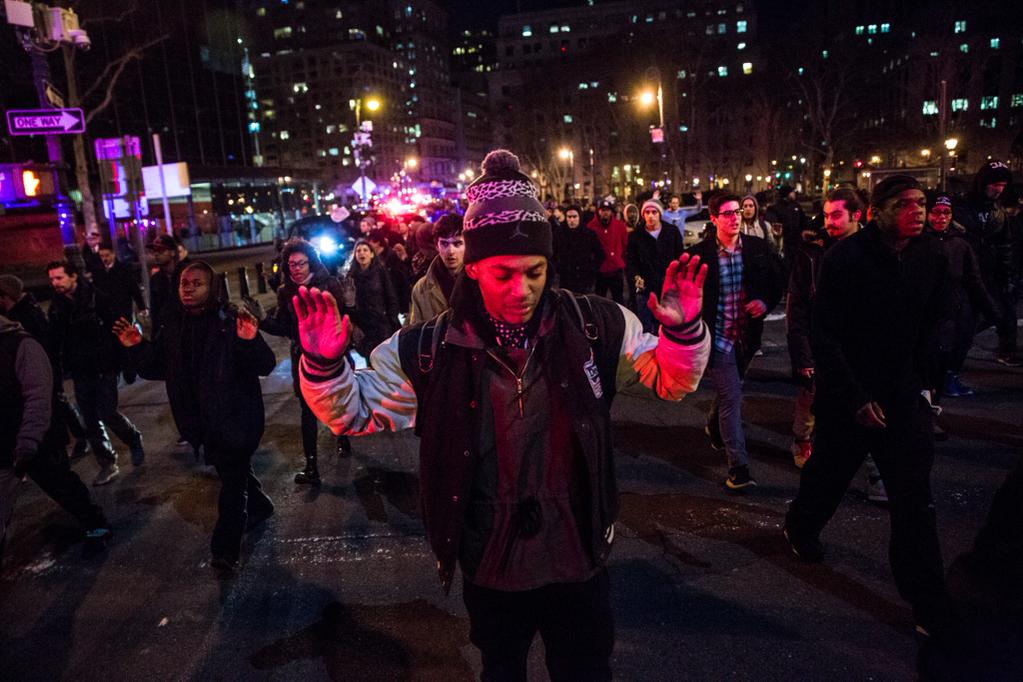
Protesters on Wednesday evening in New York (photo: William Alatriste)
Good morning. I'm incredibly appreciative that school is in session today in New York City and that you're there to care for our children. I thank you for the leadership you show and the responsibility you embrace every day. I wish I was going to be leading a classroom today, but I'm not, I left teaching a couple of years ago. So yes, I'm a quitter and you should take the thoughts I offer with whatever skepticism you deem appropriate.
Now I run this news publication. I try to educate the public about New York politics and government; and I continue to closely follow and care deeply about what happens in our schools.
I'm writing to ask that you scrap your lesson plans for the day - and probably tomorrow too.
I know the panic that this notion can instill, bumping anything a day or two often means making even more difficult an already insurmountable task of trying to fit everything in before the end of the marking period. I've been there. But, this is really important.
Today is a day for social studies in virtually every classroom in every school in this city. It's a day to study our society. It's time for current events.
Whether or not you spent some of Wednesday afternoon or evening following the decision of a Staten Island grand jury and its aftermath; and whatever you think about that decision and what has been said and done since; it's incredibly important that we make sure students know what is going on and provide them with space to process. It's important for us adults too, of course. I hope you agree.
I understand what I'm getting at here - bumping whatever you have planned for today (and maybe tomorrow) and talking with students about controversial political things that center around race and crime and protest - might be making you pretty uncomfortable. As it would. And you may have already rolled your eyes at me, which I completely understand. But, bear with me, please.
If you (or your students) haven't been following the circumstances around the July 17 death of Eric Garner on Staten Island and the case of Police Officer Daniel Pantaleo, who the grand jury decided not to indict relative to Garner's death, (or even if you have), here is a timeline of key developments courtesy of The New York Times.
Because it never makes sense to ask a teacher for a last-minute change in plans as dozens of students head for your door without offering support, there are a few other resources linked below, including video of Mayor Bill de Blasio and President Barack Obama commenting in response to the grand jury's decision and a few articles and opinion pieces.
Yes, I'm asking that you talk with your students about what is happening in New York City (and elsewhere). About race and policing and protest and justice. You don't have to have all the answers, or even most of them. You don't have to give your opinions, or even have them. You don't have to tolerate racism or hate in your classroom. But, man oh man do we have some very 'teachable moments' here. Moments for students to ask questions, talk about personal experiences, share what they might have seen or heard last night as New Yorkers marched all over Manhattan in protest.
We shouldn't pass this moment up - we should talk about these things - even in biology or algebra.
As Chancellor Carmen Fariña wrote in a memo to Department of Education staff on Wednesday morning that you may or may not have seen: "As adults, we know that there are many positive ways to respond to complex situations that result in greater insight and understanding; current events can be a great learning experience for the entire school community."
Clearly doing even a little bit of what I'm suggesting could be very tenuous, even dangerous, in many classrooms, I'm not naive. Obviously you know your students and class dynamics better than anyone else and will use your discretion. But, perhaps there's space for at least some discussion around what almost all students are surely at least somewhat aware of.
Maybe it's just the basics of the Garner incident and Pantaleo case, what happened last night, and where things stand: with federal and internal NYPD investigations underway and several more chapters likely to come in this tragic saga.
Maybe it's a discussion of whether protesters should be allowed to block traffic or of what students think police officers' biggest challenges are in doing their jobs. Maybe it's just journaling and conversation in pairs or small groups about something relevant.
You probably don't need me to tell you any of this, and forgive me if you're annoyed - I know that often the last thing teachers want to hear is other people telling them what to do in their classrooms. I'm simply hopeful that New York City classrooms will be the best places for learning that they can be, today and every day.
Thank you.
***
A brief sample of resources (note: much of the above and below is maturity and age-dependent):
The New York Times
De Blasio Reacts as Mayor and a Father (includes video of the mayor's remarks)
The New York Times
Officer Told Grand Jury He Meant No Harm to Eric Garner
4+ mins of President Obama discussing the issues at play in response to the Staten Island ruling Wednesday afternoon (YouTube via The White House)
Capital New York
Justice department to investigate Garner's death
Newsday
Arrests on Brooklyn Bridge as Protesters Fan Out Across City
DNAinfo
83 People Arrested as Thousands Protest Eric Garner Decision
Newspaper Editorial Boards:
The New York Times
A Search for Justice in the Eric Garner Case
The New York Daily News
The Eric Garner 'chokehold' grand jury decision has the earmarks of a gross miscarriage of justice
The New York Post
No indictment
New York Newsday
Eric Garner Case Decision Defies Belief
Something different, but very relevant (probably only appropriate for high school and beyond):
NPR
#CrimingWhileWhite Opens A Prism On Police And Race
***
by Ben Max, executive editor, Gotham Gazette
@TweetBenMax
email me: This email address is being protected from spambots. You need JavaScript enabled to view it.
Jobs Task Force Report Shows Progress, But Much More Must Be Done For Young Adults
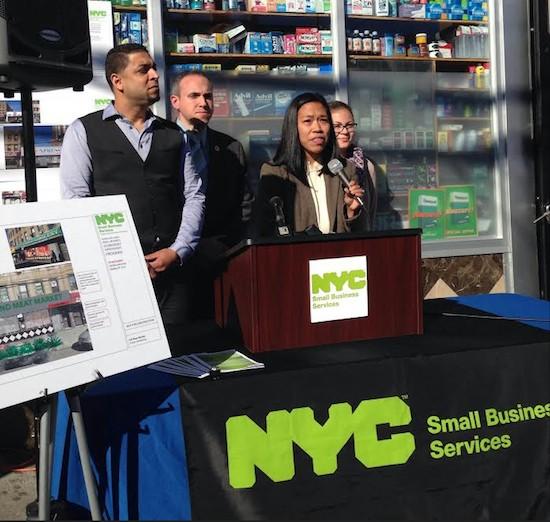
Small Busniess Services Commissioner Torres-Springer (photo: @SBSNeighborhoods)
Although New York City's unemployment rate has plummeted in recent months, economic recovery remains little more than a rumor for the more than 300,000 New Yorkers between 18 and 24 years old who are not in school and out of work or stuck in low wage jobs—a number comprising 35 percent of all New Yorkers in that age range. For this group, the shortcomings of New York City's workforce system bear depressing similarity to the drawbacks that marred their experiences in public education. Both offer too little relevance to their current challenges and long-term needs.
The workforce system's disconnection from economic development investments and priorities, and the failure of many related programs to deliver market-relevant education and training, do not serve young adults who need to build skills and gain experience.
This past spring, Mayor Bill de Blasio convened the Jobs for New Yorkers Task Force, a 30-member committee of noted corporate executives (including JobsFirstNYC board member Greg Hambric of Modell's Sporting Goods), educators, philanthropists, union leaders, city officials and nonprofit service providers, to develop strategies to strengthen the city's workforce system and help workers to secure well-paying jobs in high demand careers. The Task Force was assigned to make recommendations to spend the City's nearly $500 million workforce development budget more effectively. The recently released Career Pathways: One City Working Together, fulfills this charge.
A bid to shift the system's focus from quick placement into low wage jobs to emphasis on careers, the scope of Career Pathways is unprecedented. The recommendations would shift how the City spends more than $150 million annually and impact operations within no less than eight city agencies, including the Department of Education and the City University of New York, as well as hundreds of business owners and nonprofit organizations. The task force identified two major organizing principles to enable this change: Industry Partnerships and Career Pathways. While both strategies offer promise, the report leaves many crucial questions unanswered.
Industry Partnerships would serve as intermediaries between employers and service providers. But the report does not address the structures or authority of these partnerships, nor does it identify what role nonprofits will play within this structure. Career Pathways align and coordinate education and training programs toward career progression. Exactly how the City will manage this complex transition from rapid attachment to career development is not discussed in the report.
Also unclear is how the plan would change the career trajectory of those young adult New Yorkers who lack the skills to compete for jobs that pay living wage or stuck in low-wage jobs.
One option for the City to consider is work being done by organizations like JobsFirstNYC to develop sector-based partnerships that may also be well-positioned to support certain constituents like young adults. The Young Adult Sectoral Employment Project, created by JobsFirstNYC and supported by private philanthropy, could serve as a primer for developing a broader array of industry-specific partnerships.
Given the scale, complexity, and duration of the challenges facing young adults in the labor market, we urge the City to formalize a position with respect to this important group and identify a vehicle that can help more of these young adults connect to training and educational opportunities, as well as to employers.
JobsFirstNYC has proposed the creation of a network of Youth Opportunity Centers in the 18 communities that are home to more than half of the 35 Percent. Because so many of these young adults are unlikely to seek assistance outside their communities, we must bring help to them.
The Youth Opportunity Centers—operated by community based organizations that are known and trusted by residents—could serve as the locus for a range of services to reconnect young adults to education, help them to develop career plans, and link them to training, internships, apprenticeship programs, and jobs. Similar models across the country, such as the Los Angeles YouthSource Centers, have proven highly effective at connecting more young adults to education and employment.
While the City's thoughtful and long-overdue reassessment of its approach deserves credit, it is much easier to release a report than to actually see through a years-long effort of systems change. As the Mayor's Office of Workforce Development and key workforce agencies—including the NYC Department of Education, Department of Small Business Services and Human Resources Administration—begin to implement the recommendations of the Task Force, we urge them to engage a constellation of other actors who have experience in developing industrial partnerships (better known as sector partnerships), and career pathways training. Likewise, partners in this work must include nonprofits who will deliver services on the ground, and customers themselves.
The recommendations made by the Jobs for New Yorkers Task Force carry potential for real progress toward increasing the incomes of low-income New Yorkers, and represent an important start toward creating a workforce system worthy of the City it serves. But the real work has only just begun, and we hope the City will engage the full range of actors necessary to address such an ambitious agenda. At JobsFirstNYC, we remain focused on advancing economic opportunity for all young New Yorkers.
***
Louis Miceli is Executive Director of JobsFirstNYC, a nonprofit intermediary focused on connecting young adults to the economic life of New York City.
An Essential Use of the State Budget Surplus

FDNY Foundation is one Human Services Council member organization (photo: FDNY Foundation)
Thousands of New York State residents depend on the state's non-profit human services organizations during times of disaster and unforeseen crisis. But unless we reinvest in this struggling industry, New Yorkers could find themselves left without resources in their greatest time of need.
Following the attacks of September 11th and the aftermath of Superstorm Sandy, human services organizations emerged as indispensable first responders that know the intricate needs of their communities. They are on the front lines providing for basic needs like food and water, safe shelter, crisis counseling immediately following a traumatic event, and extended ongoing assistance related to housing, jobs, legal matters, finances and mental health.
Employees of human services organizations have embraced opportunities to support those victimized by disasters. After Superstorm Sandy, the State awarded a contract to provide case management services for victims who needed help with housing, health care, transportation, and a myriad of other services. The Disaster Case Management program has thus far served approximately 9,700 cases, 5,000 of which remain active.
Unfortunately, the majority of human services organizations are not adequately funded by the State. Since 2010, the State has cut $1 billion from this sector, leading to the loss of 27,000 jobs. In a recent survey of the state's non-profit sector, 42% of respondents said they do not have the resources to continue to operate over the next three years.
For nonprofits to assist in disaster response and recovery, they must be fiscally sound. After Superstorm Sandy, local organizations provided frontline assistance at a significant monetary expense with no guarantee that they would be reimbursed; in fact, in a survey after the storm, only about 20% of surveyed organizations expected to be reimbursed for services provided. After September 11th, nonprofits relied on deficit spending and endowments to buy what was necessary and serve where they could, but after Sandy, many felt that similar actions would put their organization's finances in jeopardy.
Our ability to react effectively to another disaster is very much in question. If another disaster like Superstorm Sandy were to happen tomorrow the human services sector would not be financially prepared to yet again address the immediate and ongoing needs of our communities. This is a very troubling situation.
Fortunately, a remedy lies in the state's $5 billion budget surplus.
The Human Services Council, an association of approximately 200 of the state's leading human services organizations, is currently leading a campaign calling on Governor Cuomo to include a $354 million investment in the human services sector in the next Executive Budget. This would ensure that organizations providing disaster relief have the tools to react effectively when needed, help stabilize the sector, and save jobs.
For five years, the State has deferred its statutory responsibility to provide cost-of-living increases to contracts for state-funded human services, a total loss of $354 million to the sector. This short-sightedness has translated to thousands of layoffs, no raises for the employees providing disaster relief services, and the severe straining of our state's system of human services delivery.
A strong nonprofit infrastructure is crucial to communities, especially in a disaster where nonprofits can be first responders. Nonprofits must have the resources to act when needed, and the current state of funding for human services has crippled our ability to serve. A $354 million investment by the State would alleviate these concerns.
With a virtually unprecedented state budget surplus of $5 billion projected for the next year, Governor Cuomo must not miss the opportunity to better equip human services organizations to ensure the well-being of our citizens - and to continue to leap to the forefront when disasters occur.
***
by Allison Sesso, Executive Director, Human Services Council, Inc. Find her on Twitter @AllisonSesso
Do you have an op-ed idea or submission for Gotham Gazette? Send it to Executive Editor Ben Max: This email address is being protected from spambots. You need JavaScript enabled to view it.
The Case for Uber Data Sharing

(photo: @Uber)
The e-receipt from your last Uber ride isn't the only record of your trip. The base that dispatched your car records a "what, when, and where" of your journey, and that information is available to the Taxi and Limousine Commission (TLC) upon request.
Soon, if the TLC's proposed rules are approved on Thursday, November 20, the agency will start storing that data on its servers and require bases to report regularly in a more efficient standardized format. As might be expected, the proposed rule change is letting an old simmering fight boil over: self-professed protectors of the free market, like Uber, are raising privacy concerns. But if Uber's comments at the TLC's October hearing are any indication, the for-hire car company is using privacy as a pretext for protecting its business interests. That makes me skeptical.
Uber is trying to vilify all data gathering when what it really wants to do is keep secret its market share. Data analysis is not inherently a bad thing, especially when accompanied by transparency, regulation, and indicia of trust.
It's hard to argue, as Uber has, that the change will intrude into driver privacy in the traditional sense. Except for identifying the car's home and dispatching bases, the information is already being recorded and required of all licensed for-hire cars in New York City. Plus, the TLC isn't interested in sensitive information about drivers, customers, or for-hire car companies. It isn't even asking for drop-off data, just pick up, base, and license information. And, in any event, the TLC gathers much more detailed information from yellow and green cabs.
But the rule may raise a different kind of privacy concern (and here, I'm relying on the work of privacy scholars like Helen Nissenbaum at NYU and Dan Solove at George Washington University Law School). Let's call it an accessibility problem. There's a big difference between, on the one hand, data being stored in fifty different dusty file cabinets at fifty different bases and, on the other hand, that same information being gathered together into one Excel spreadsheet and accessible on a government server.
I'm not referring to the statistically insignificant likelihood of a leak; any such concern is highly exaggerated. Rather, it's about access and the ease of analysis, aggregation, and (mis)categorization.
That is, admittedly, a very real concern. Recently, in the New York Times, Maryland Law Professor Frank Pasquale warned that an entire industry of data miners is pulling the floor out from under us as it skates by in the dark corners of the unregulated internet. He reminded us that real people can face real harms when sensitive information like prescription drug or medical histories gets tossed into the heap of a Kafka-esque "big data" regime.
But those real dangers are just not applicable here, and it is disingenuous for a company like Uber, which admitted at the TLC's October meeting that it was chiefly concerned with keeping secret its market share data, to turn all information gathering techniques into automatic evils.
Trip data is not as sensitive as, say, a list of prescription drugs we take. Nor is it anything like our telephone call history or our Facebook passwords. The TLC's requested information is sufficiently general so as to make it inordinately difficult, if not impossible, to find out who drove whom where and for how much. Drop-off and fare data, again, are not included.
Plus, this data could provide all sorts of benefits for the TLC and for New York City: from making it easier to keep customers safe, identify dangerous drivers, and investigate customer complaints, to helping determine which City neighborhoods are underserved by for-hire cars, assess the continued value of old laws in a world with a vibrant for-hire market, and evaluate new TLC programs, to name just a few. Data can be a wonderful tool, if used appropriately.
The question then is not whether this data collection should happen at all; rather, it is how it happens. We want information gathering to happen in a manner that protects our interest in privacy, inspires public trust, and serves the TLC's mission and the general welfare.
To those ends, the TLC should continuously fine-tune its protocols to ensure that it is a trusted guardian of trip data. And it is doing just that. It has narrowly tailored the rule to provide it with the minimum amount of data necessary to achieve its public safety goals. The TLC has appropriately balanced privacy interests with its other obligations by limiting what could be released under a Freedom of Information Law (FOIL) request. It has developed internal protocols to keep trip data secure so that only employees who need access to these data to do their jobs would have the login and password to access the data. And it is approaching this policy change by being transparent about what is being requested, how it is being stored, and what could be released.
Privacy interests are fundamental to who we are as a society, and governments need to take them seriously by seeing themselves as stewards of our information. But data collection can open doors: it can help us create a more intelligent, more efficient, more just society. It will take a public-private partnership to do that. Manipulating the public by waving the privacy flag, however, is not good corporate citizenship.
***
Ari Ezra Waldman is Associate Professor of Law and Director of the Institute for Information Law and Policy at New York Law School. You can follow him on Twitter at @ariezrawaldman
Brother Can You Spare A Dime? For a Bag
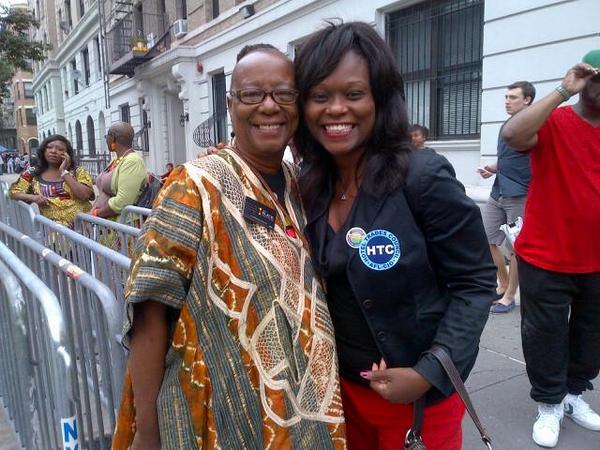
The author, Bertha Lewis, left (photo: @Vote_Bichotte)
A recent New York Times column examined "The Source of New York's Greatness," and its conclusion was no surprise: our greatness comes from our status as the preeminent melting pot, both culturally and economically. We are home not just to doctors, lawyers, and bankers, but to bodega owners, shoe shiners and deli chefs. So I wonder what one of our great orators would say about the New Dime Bag?
New Yorkers, YOU BEEN HAD! A ten cent tax on plastic bags, specifically the regressive tax introduced by Council Members Brad Lander and Margaret Chin, is counter-intuitive, and hurts the working class and small business owners that make our city strong. Our communities are still struggling to make ends meet, still suffering economically from the recession, and still suffering from the effects of Hurricane Sandy. We shouldn't be asking our citizens to hand over any more of their hard-earned money at the grocery counter, especially when their communities won't reap the benefit of their investment.
New Yorkers, YOU BEEN TOOK! It is hard enough for our city's working families to balance multiple jobs, multiple children, and a checkbook, without having to also worry about whether or not they remember to bring a reusable bag. Council Members Lander and Chin have tried in part to alleviate this issue by proposing to waive the tax for those on food stamps. Unfortunately, this "remedy" creates more problems than it solves. Despite an exemption for SNAP recipients, New York's working poor must still pay this tax.
New Yorkers, YOU BEEN HOODWINKED! Additionally, many small businesses are opposed to this legislation, as they would be unnecessarily burdened to enforce it. The bill is very clear on how businesses will be fined, but is conveniently vague on how small business owners should keep track of their plastic bag compliance. The bill does not mandate any sort of paper trail to help businesses prove that they are in fact complying with the new tax. Why are we making things more confusing for our small businesses, instead of helping them run more efficiently?
New Yorkers, YOU BEEN LED ASTRAY! This bill is supposed to help the environment, but the goals don't match up to reality. Plastic bags make up only 2% of the waste stream, and are nowhere near the top of the list of glaring environmental priorities for our citizens. Reusable bags are also produced overseas from petroleum, a process that is harmful to the environment. Additionally, plastic bags are 100% recyclable, and are reused in a number of ways around the house.
New York City Council has RUN AMOK! If Council Members Lander and Chin really want to make an impact, they should focus their efforts on causes that more directly benefit constituents. A recent survey found that, by a margin of 2:1, voters believe taxing plastic bags is a distraction. New Yorkers think job creation (24%), affordable housing (22%) and quality public schools (18%) are the most important issues for lawmakers to address.
Bag tax supporters like Lander and Chin hurt their constituents by further supporting the punitive and regressive tax on plastic shopping bags. Before writing and supporting legislation, our elected officials should take the time to think through their actions and consider the range of effects their proposals will have on their communities, and not just themselves. Think about all New Yorkers. DUMP THE DIME BAG!
***
Bertha Lewis is President and Founder of the Black Leadership Action Coalition (BLAC).
Do you have an op-ed idea or submission for Gotham Gazette? Send it to Executive Editor Ben Max: This email address is being protected from spambots. You need JavaScript enabled to view it.
New York at Bargain Basement Prices
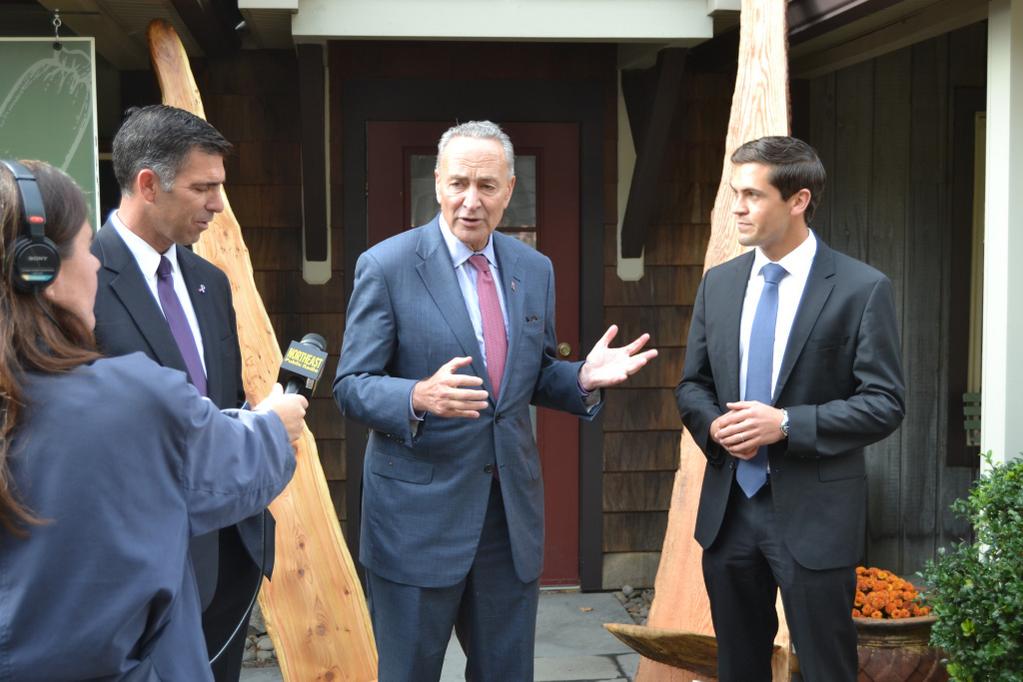
Sen. Schumer, middle, with Congressional candidate Sean Eldridge, right (photo: @SeanEldridge)
The Center for Responsive Politics estimates that candidates and their supporters spent nearly $4 billion in this year's election. For once, however, New York is a bargain, one of the least expensive places in the country to win a seat in Congress.
(Estimates are based on data released from the Federal Election Commission on Nov. 4)
It helps that neither of our two Senators were up for re-election this year. The top five U.S. Senate races alone totaled nearly $180 million in direct spending, with Minority (soon to be Majority) Leader Mitch McConnell spending $25 million to defeat his opponent, Alison Grimes, in Kentucky.
But in the House, a slew of uncompetitive races meant the entire 27-member New York delegation together raised just $42.1 million, an amount less than the top four House Republicans, who combined to raise $49.3 million. And special praise, perhaps, should go out to Congressman Jose Serrano, who raised the sixth least amount ($178k) of all House incumbents, and won with 97% of the vote. We can only hope that Congressman Serrano was busy legislating for New Yorkers, rather than spending most of his time on the phone to donors, like many of his colleagues across the country.
There were a few expensive campaigns in the state, especially the 19th district race between Congressman Chris Gibson and Sean Eldridge. Together they raised more $7 million, and the race ranked in the top 10 in terms of dollars raised in House.
Of course, just because the incumbents in the state weren't that busy raising money, didn't mean our state was completely left out. New York remains the place where candidates and Super PACs from across the country come to raise money. The state's residents were third behind the District of Columbia ($298 million) and California ($294 million) with $192 million in contributions (82% from New York City alone), two thirds (61%) of which went to Democrats (figures based on reporting as of Oct. 25). New Yorkers in the Upper East Side's 10022 zip code alone gave $30 million, second only to those in 94104 (San Francisco, CA) which gave $73 million.
In 2016, things may change for our state. Not only is Senator Schumer up for re-election, we may have our own, semi-home grown candidate in the presidential race. We escaped the full political ad blitz in 2014, but we may not be so lucky in two years.
Regardless of who does or does not ultimately enter the presidential contest, total spending on the campaign is likely to dwarf this midterm year and all previous presidential year elections. If historical patterns hold, it is likely that total spending in 2016 will top $8 billion, making it the most expensive campaign in U.S. history. Candidates will again seek out New Yorkers to support their bids for elected office, as will organizations with a special interest in certain issues. We may even get to see more of those salacious attack ads that voters in Georgia, Kentucky, and New Hampshire are probably glad to be rid of for a little while.
***
Heath Brown, Ph.D., is assistant professor in the Department of Public Management, John Jay College, City University of New York. You can follow him @heathbrown
